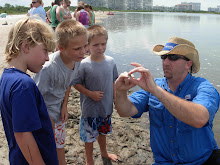 |
| Image credit: Bryan Fluech |
 |
| Image credit: FWC |
Jimmy
A male blue crab is known as a "Jimmy." They have blue tipped claws and their apron can be described as being shaped like the Washington monument or an inverted "T". Jimmies can be found throughout the estuary and also travel in to fresh water.
 |
| Image credits: FWC |
Sally
An immature female blue crab is called a "Sally" or "she crab". Like a mature female she will have orange to red-colored claw tips, but the shape of her apron is different. The apron of a sally is triangle-shaped. It can also be thought of as an inverted "V". Because she has not reached sexual maturity yet, the apron will be tightly sealed.
 |
 |
| Image credits: FWC |
Finally, a mature female blue crab is known as a "Sook". She too will have orange to red-colored claw tips, but her apron is more bell shaped. It is often said it likes the dome of the U.S capital building. She will hold her eggs (or sponge) within this apron. Females crabs can be found throughout the estuary as well as offshore in higher salinities.
 |
| Image credit: FWC |
If you would like to learn more about blue crabs visit: www.bluecrab.info/




No comments:
Post a Comment